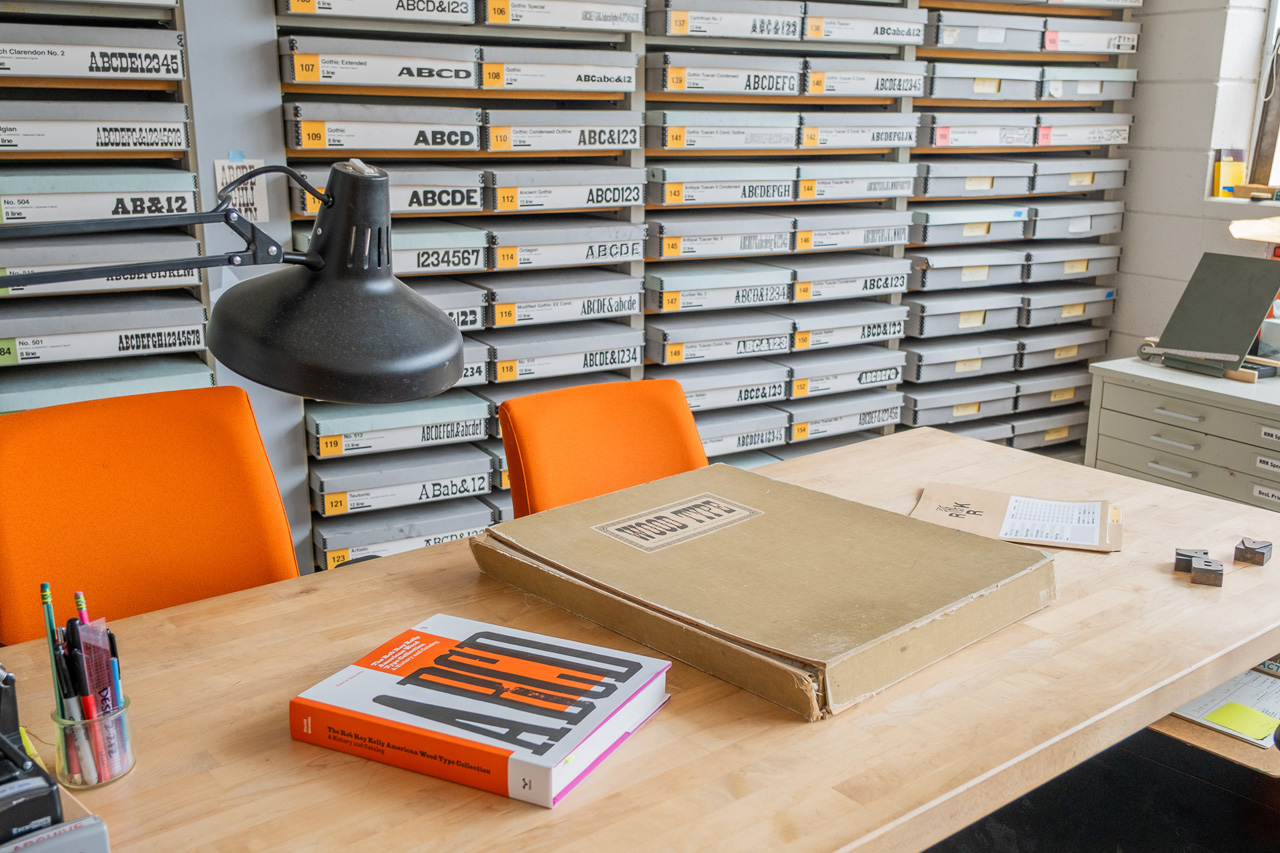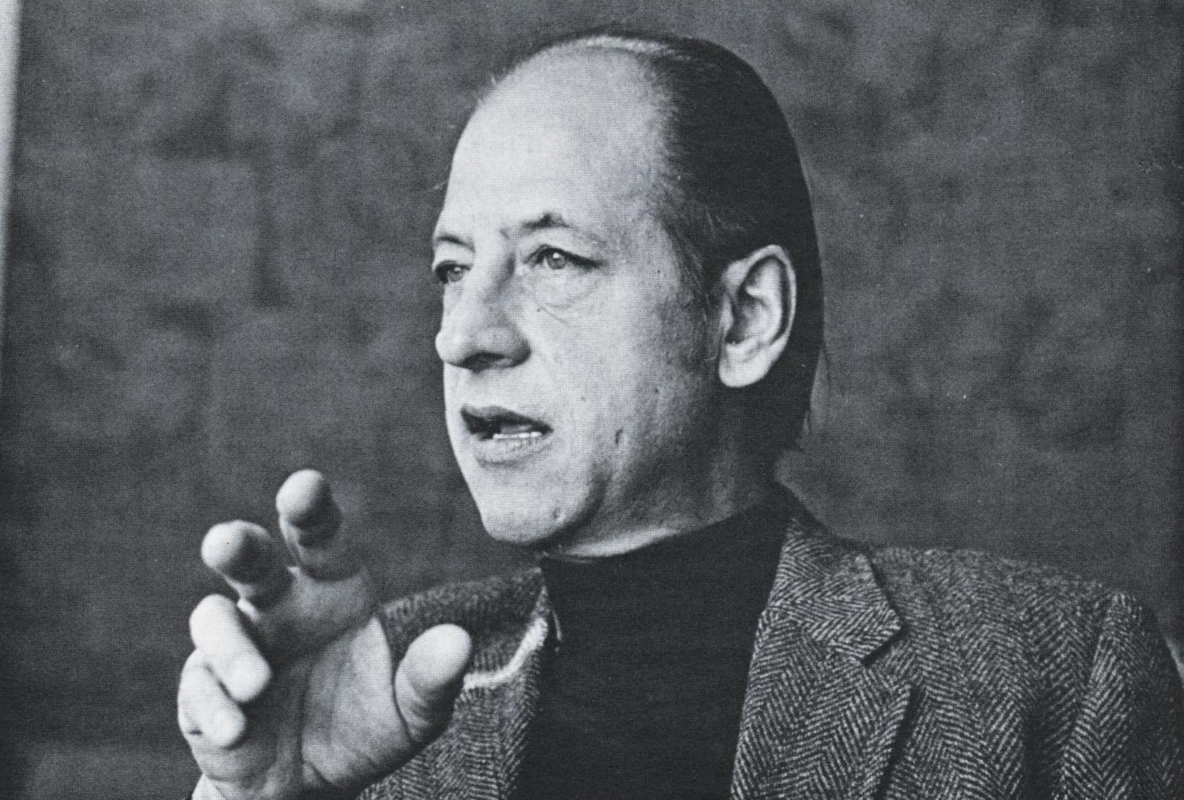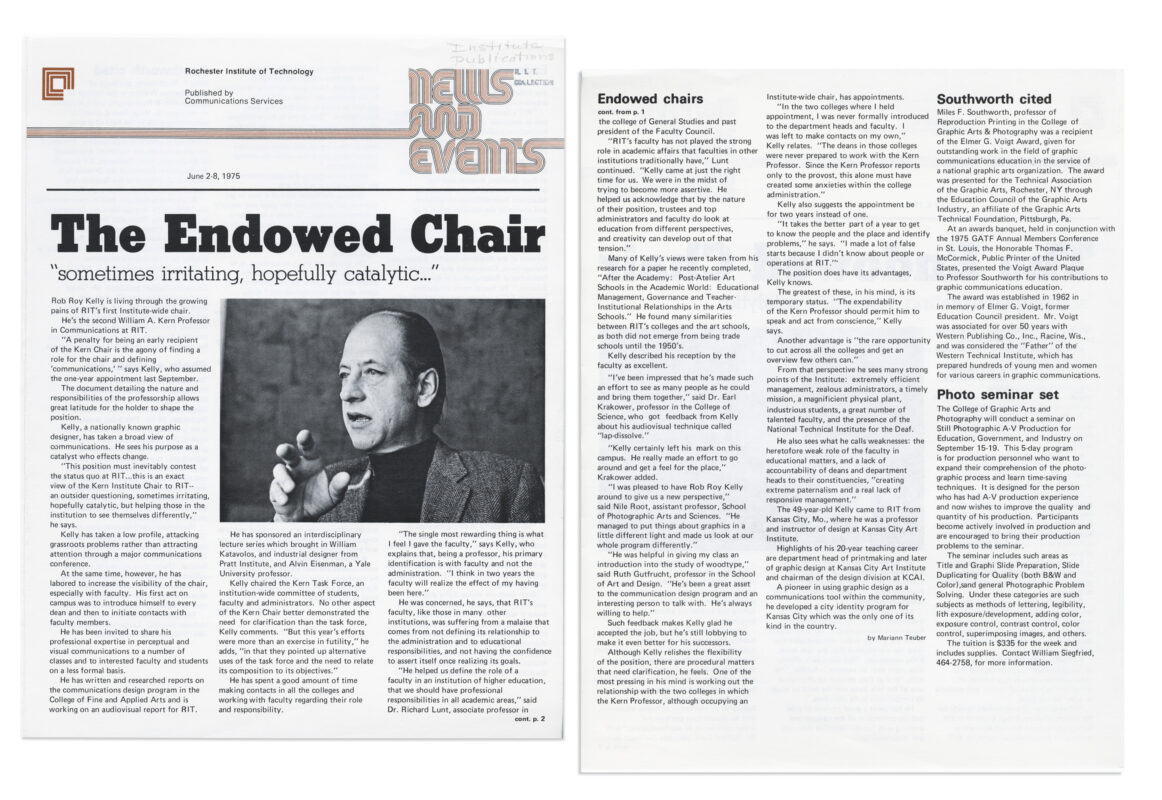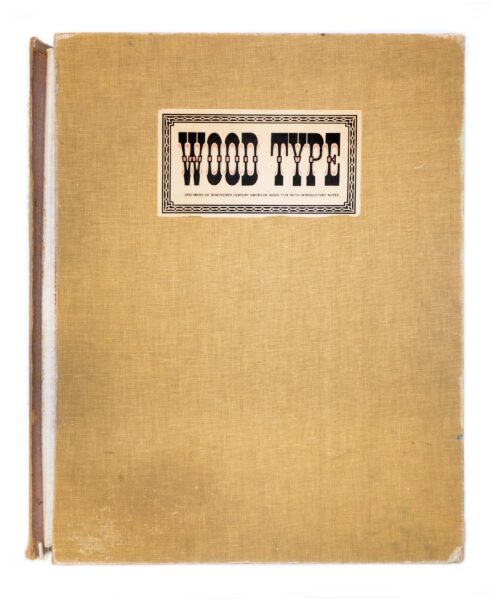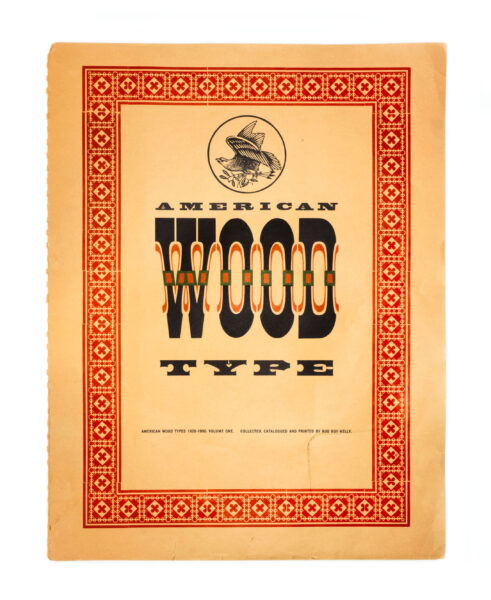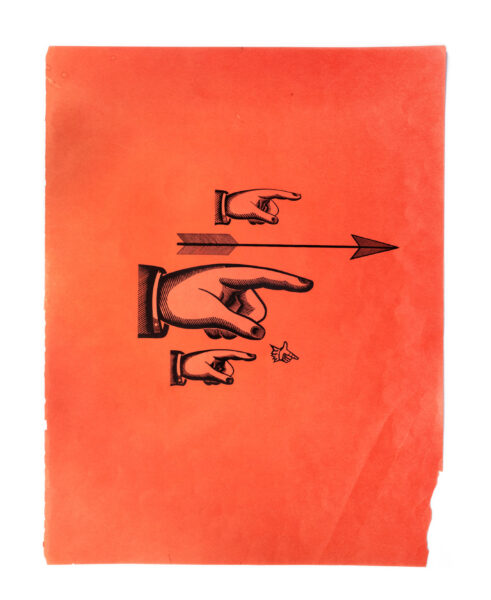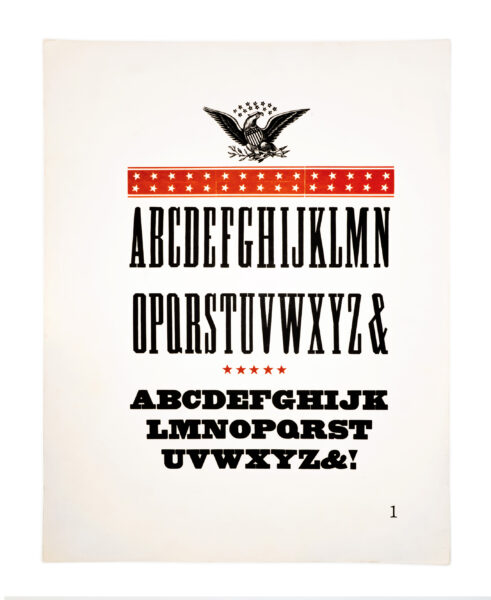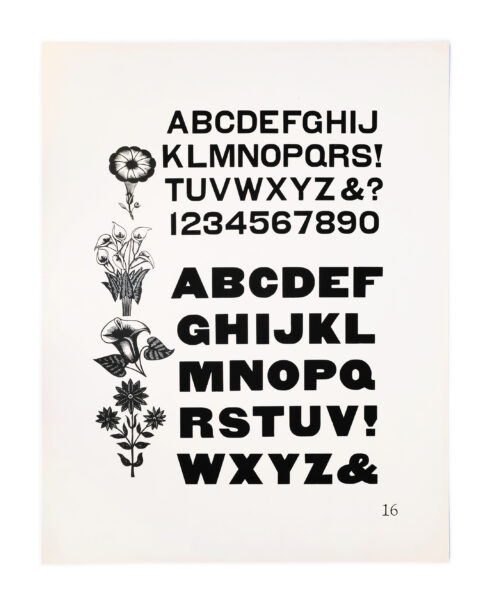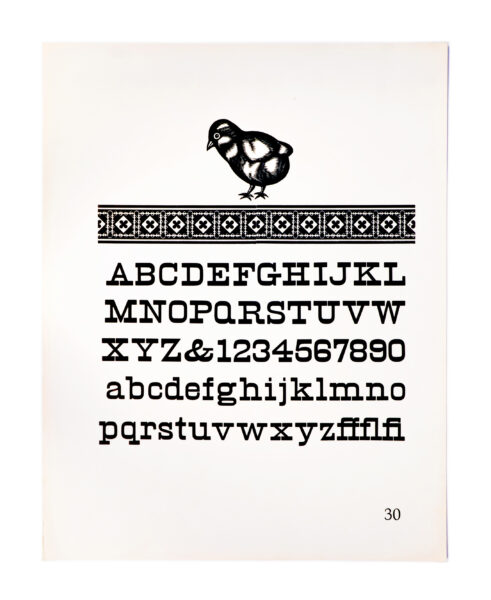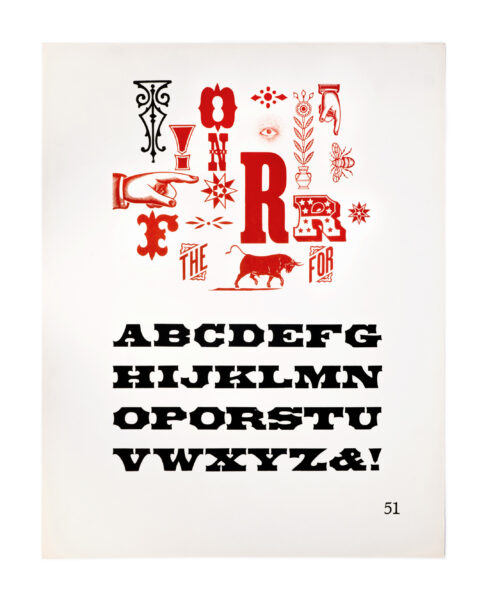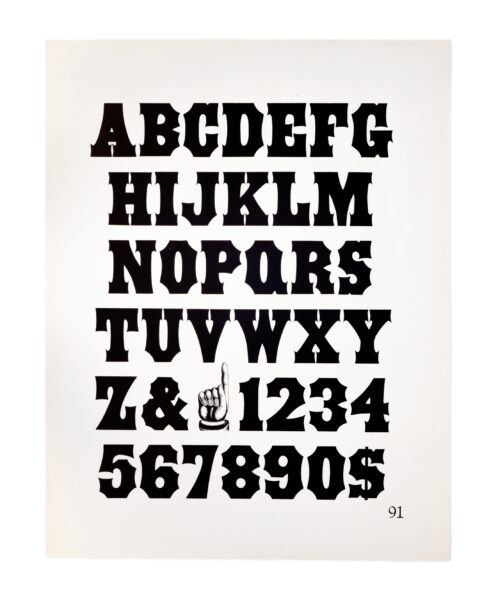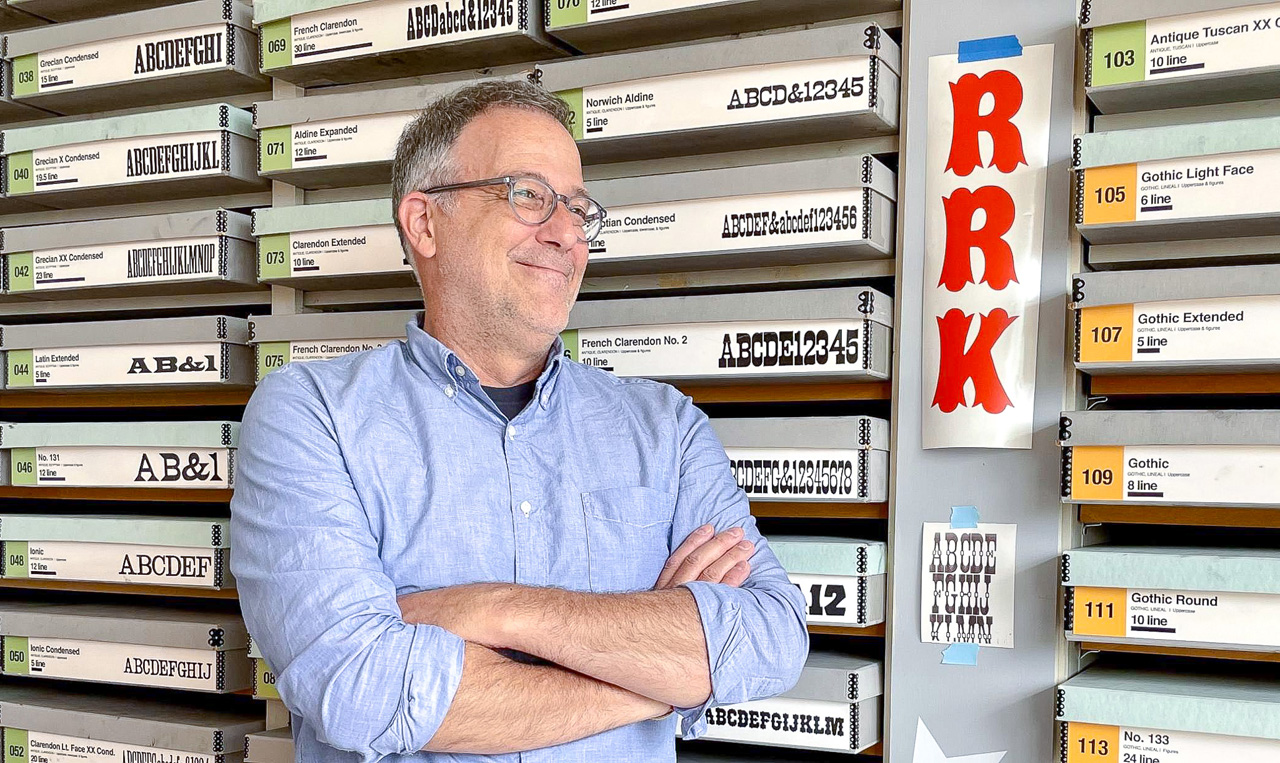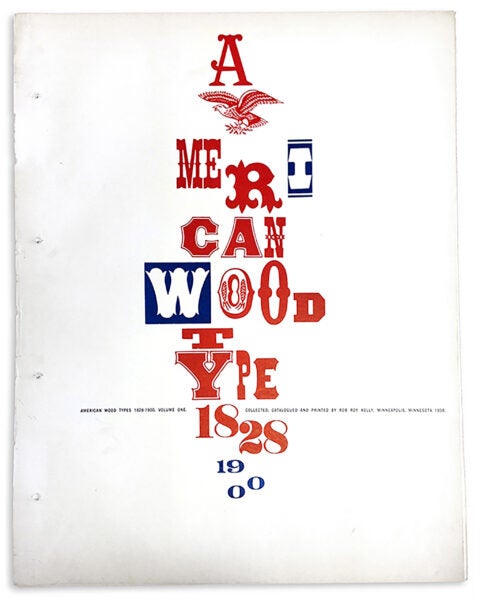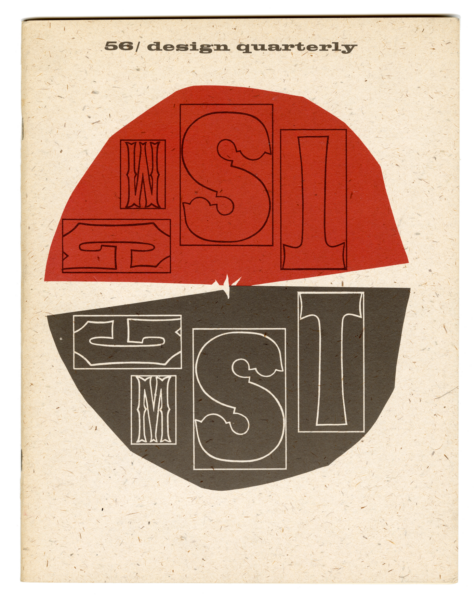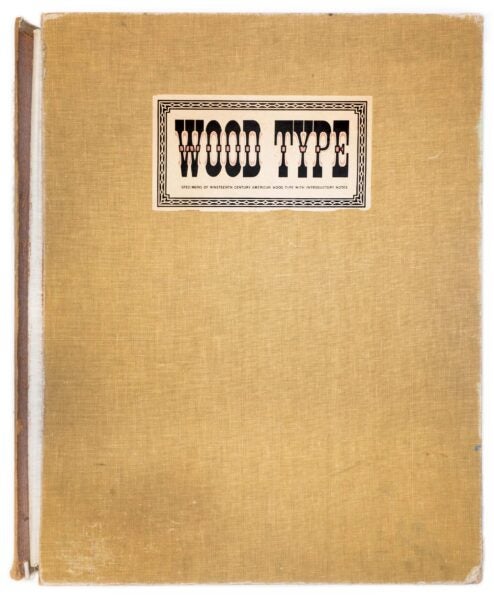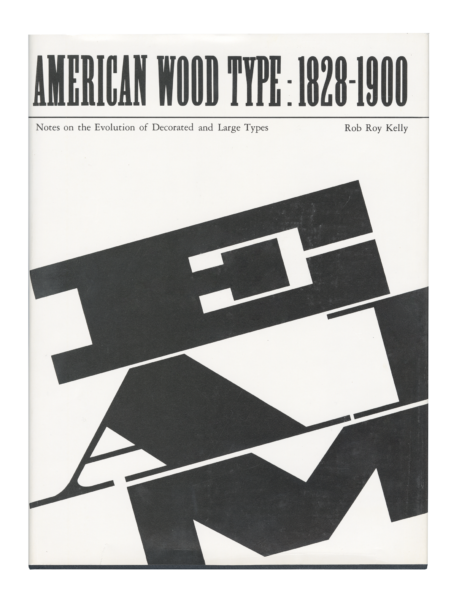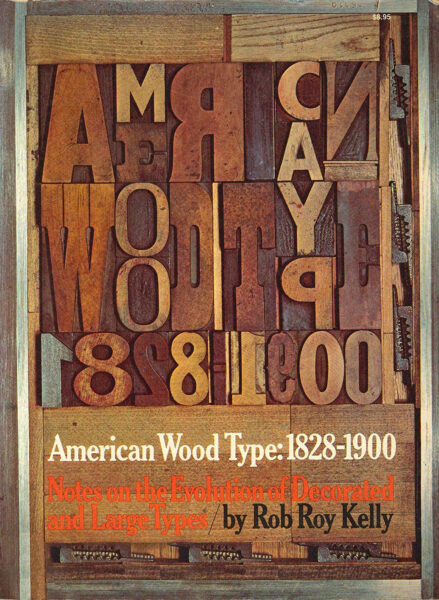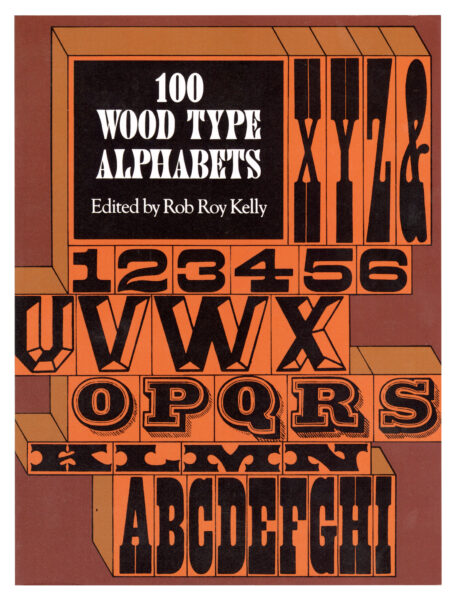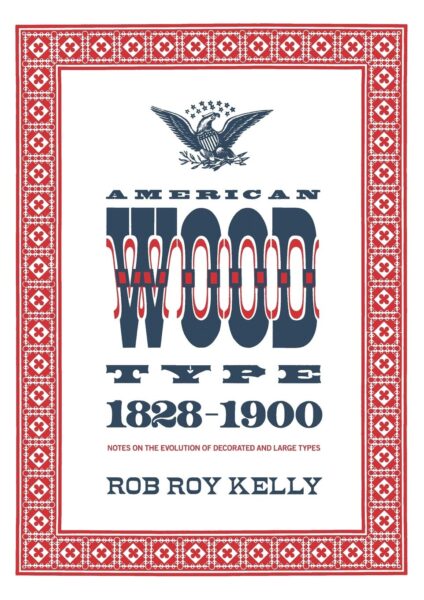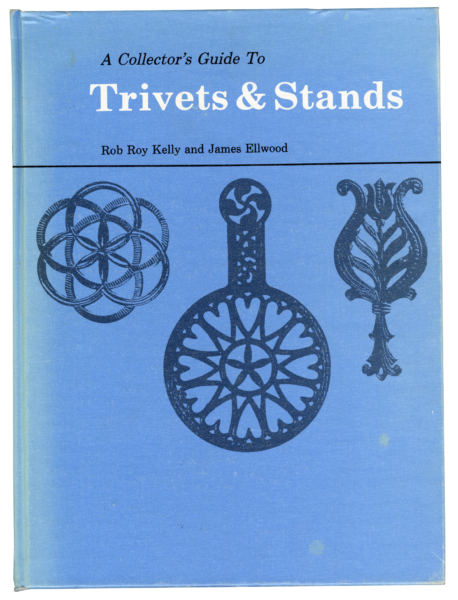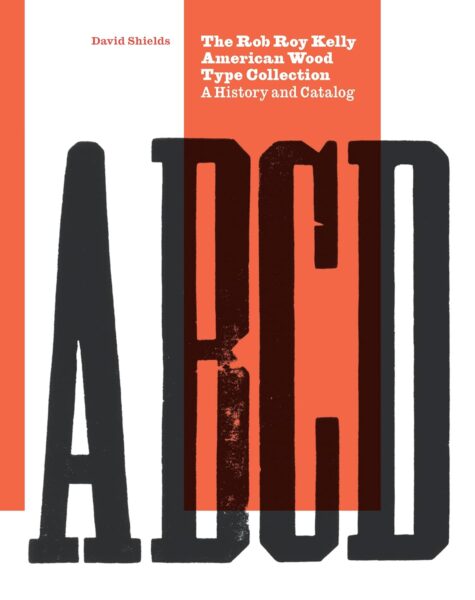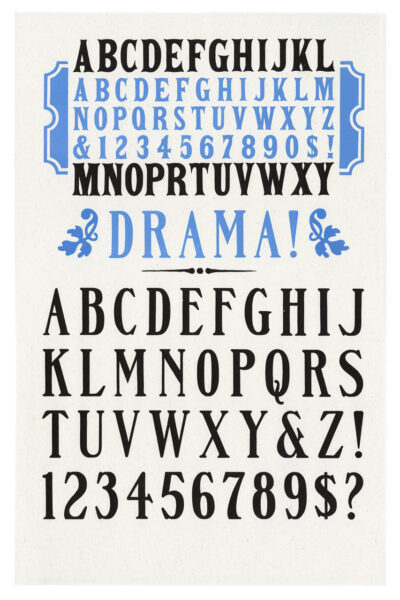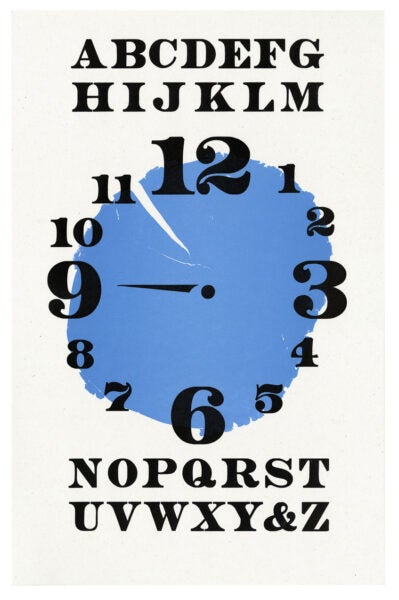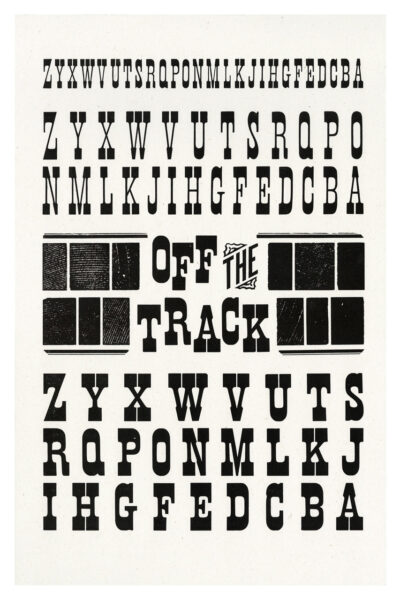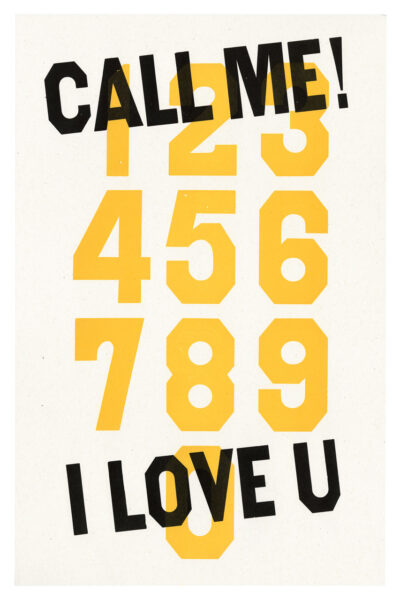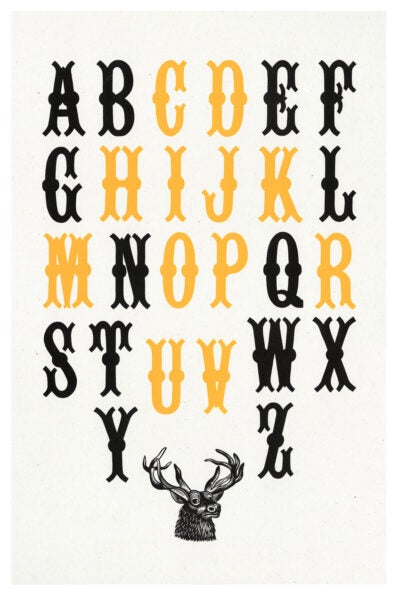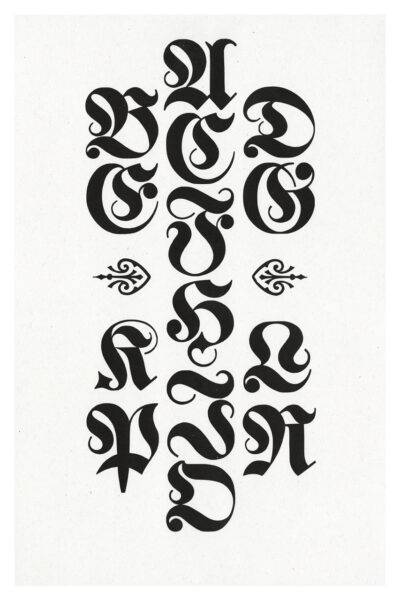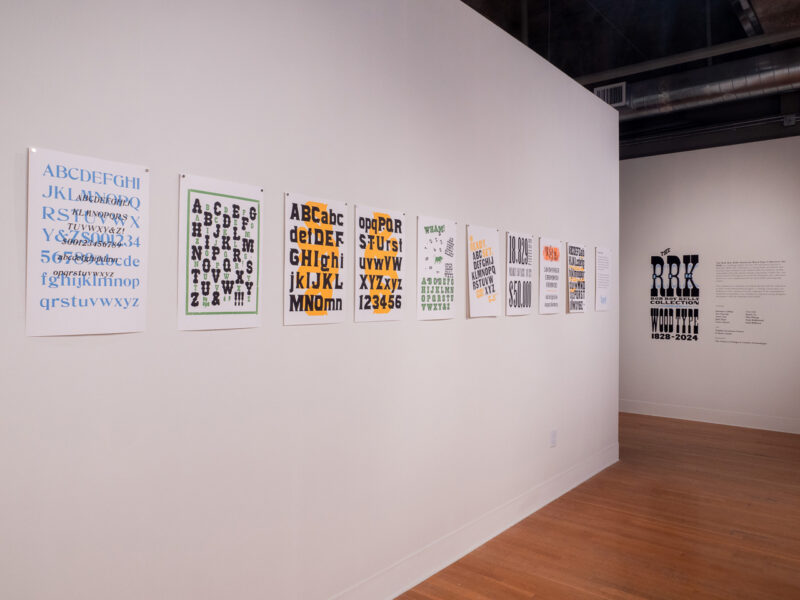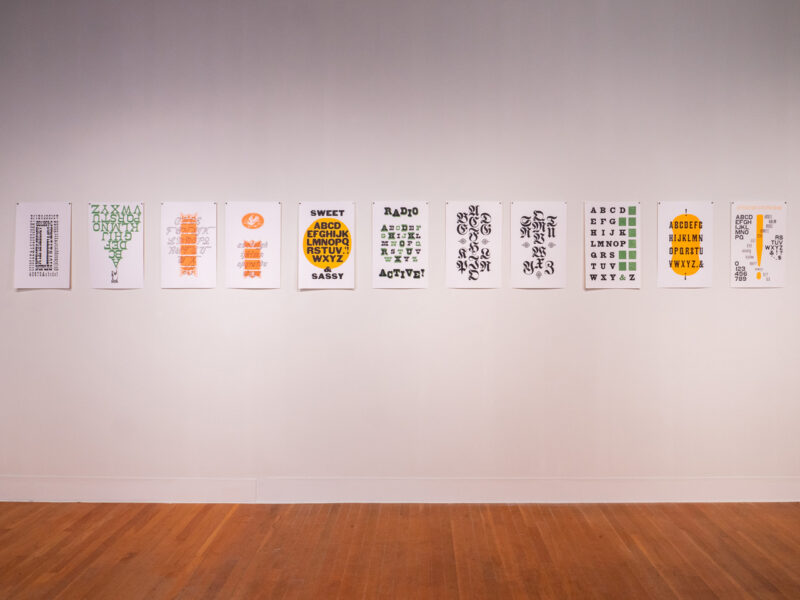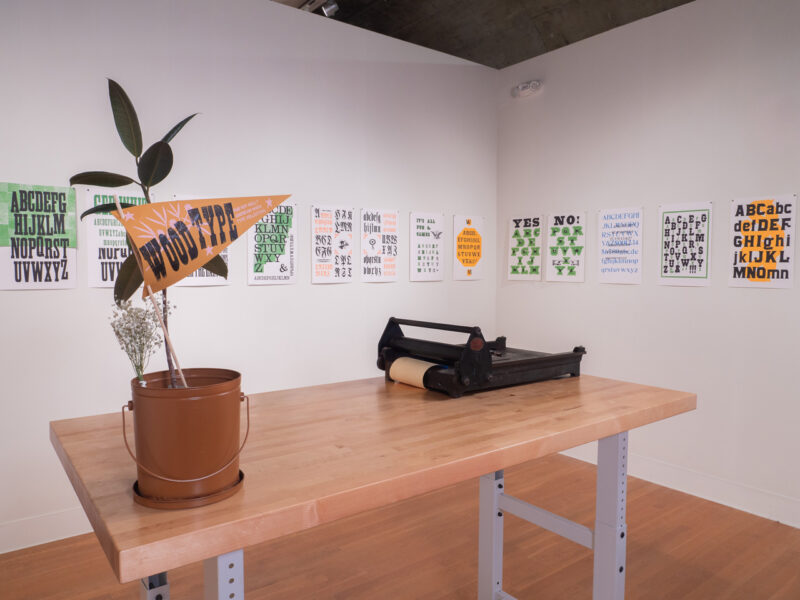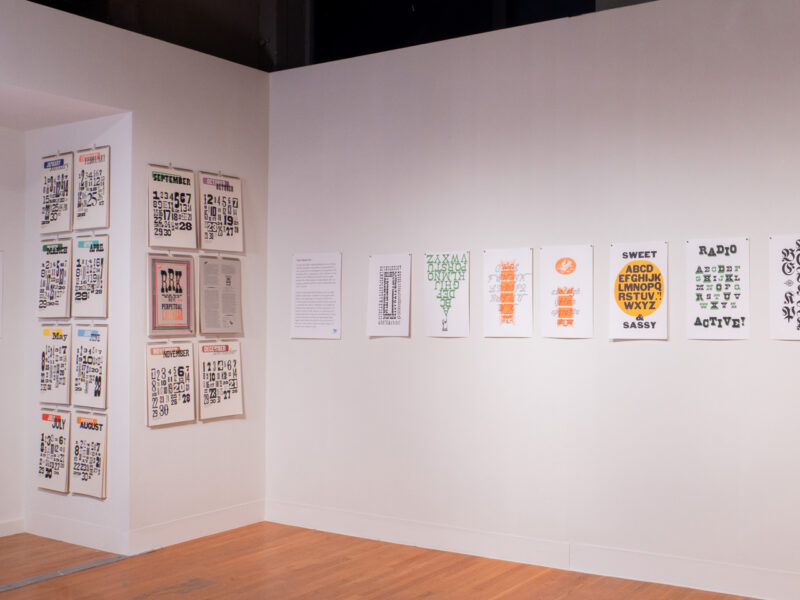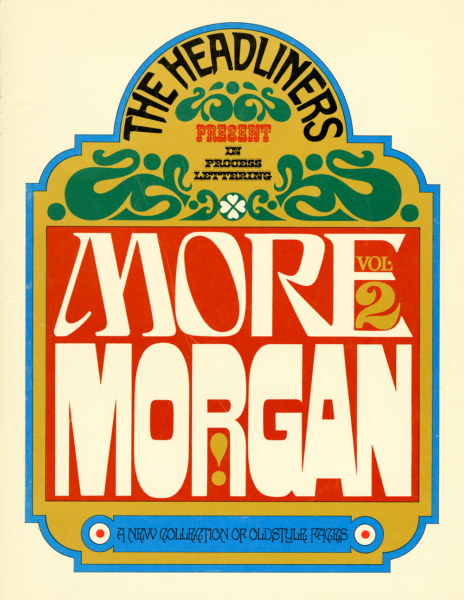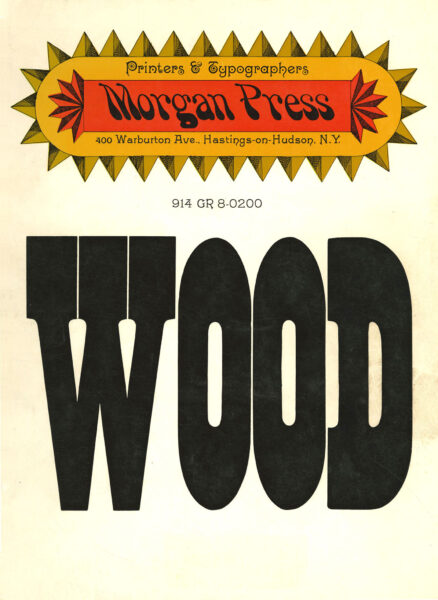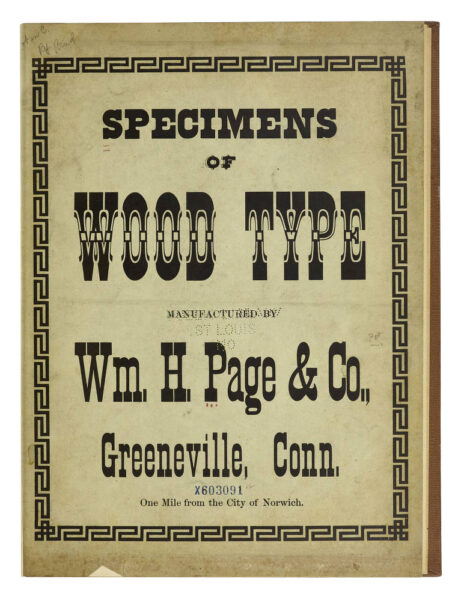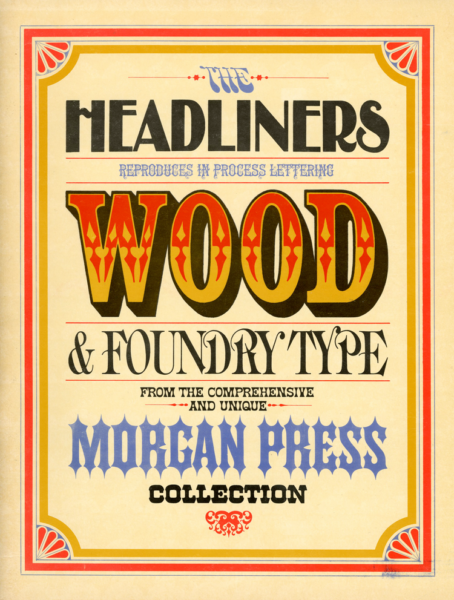History
The RRK is a collection of American nineteenth-century wood type, assembled by the noted design educator, collector, and historian Rob Roy Kelly (1925–2004).
Overview
The Rob Roy Kelly American Wood Type Collection (the RRK) is a working archive of over 150 letterpress typefaces from the 1800s. The collection is a living body of artifacts and resources that continue to be utilized daily by students, faculty, and scholars from the greater design community. Under the care of the School of Design & Creative Technologies at the University of Texas at Austin, the collection thrives as a core component of our curriculum and ongoing studies.
But wait, what is Wood Type?! Here’s a quick introduction.
The collection is named for Rob Roy Kelly, a design educator and scholar of letterpress technology and history. Kelly began accumulating wood type in 1957, initially as a resource to utilize with his students. Realizing that little scholarly material existed on the topic, Kelly took it upon himself to amass and study his own archive. The collection displays an overview of wood type progress and production throughout the arc of the 19th-century, from 1828 to 1900. Kelly’s research culminated in a 1969 monograph on the collection
and wood type history. He also published a limited edition folio of specimen prints he produced himself with the collection.
Following the completion of Kelly’s publications, the collection was acquired by the Harry Ransom Center (the HRC) here at UT Austin, and eventually made its way to the College of Fine Arts for continued use.
During its time at UT, the RRK has been utilized and cared for by generations of students, and a variety of custodians—namely David Shields, a foremost scholar of wood type, and the author of a 2022 book on the collection titled The Rob Roy Kelly American Wood Type Collection: A History and Catalog published by UT Press. The RRK now resides under the care of the School of Design & Creative Technologies, where it thrives as a core component of our curriculum and a focal point for the global letterpress community. Our work with the collection is a continuous and ongoing conversation—transpiring over two centuries—with countless printers and designers that have come before us.
Kelly’s Design Origins
Rob Roy Kelly was born in Lincoln, Nebraska in March 1925, and was adopted by Roy and Alta Kelly when he was six months old. After spending his childhood moving around northeast Texas and east-central Nebraska with his parents and two younger siblings, Kelly enlisted in the United States Marine Corps. In 1943 at the age of eighteen, Kelly joined to serve in the second World War, and endured two years in the Pacific before being honorably discharged in 1946.
Following his military service, Kelly attended the University of Nebraska, and then the Minneapolis School of Arts (MSA) on the GI Bill. Kelly returned to military service from 1950-51 during the Korean war, during which he managed the screen printing shop at Camp Pendleton in Southern California. Subsequently he resumed his studies at MSA and graduated in 1952. The following year Kelly began the MFA program at Yale University, studying graphic design. He completed that degree in 1955, and was asked to return to MSA, where he developed an undergraduate graphic design program—one of three programs he established during his career.
Rob Roy Kelly, Collector
Kelly began collecting wood type from local printers beginning in 1957 for use by his students at MSA. His first encounter with wood type had come during the MFA program at Yale, where a collection of wood and metal type was utilized in their teaching of typography. This hand’s-on engagement with letterforms and printed language was formative in Kelly’s understanding of graphic design, and he sought to carry on this tradition in his teaching practice.
The collection continued to grow over the next decade. He also began researching the history and manufacture of American wood type, inspired by his students’ questions about the topic. Discovering that little scholarly work had been conducted on the topic, Kelly was curious to map-out a yet-untold story of this significant moment in design history, and in the legacy of print technology.
In 1964, Kelly published a folio of 19th-century type specimens that he designed and printed from his collection.
It was a volume of unbound 17 x 22” prints contained in a cloth-wrapped clamshell box, released as an edition of 45 copies. Most of the copies were sold through Chiswick Book Shop in New York City, originally priced at $75. It was titled American Wood Types 1828–1900, Volume One, though Kelly never produced a second volume.
The folio includes 97 specimen prints, featuring 130 complete alphabets. 95 plates are numbered, and 2 additional unnumbered leaves display some woodcut designs and images used during the same period.
The loose prints are accompanied by a ten-page document bound with a black plastic comb.. This document includes introductory notes on the collection and some discussion of wood type history. Much of the content was originally assembled from Kelly’s research for Design Quarterly Issue No. 56, commissioned and published by the Walker Art Center in 1963.
Kelly’s original folio did not include all that is currently present in the collection—namely the German script faces and other decorative material. Additionally, it also contains a number of blocks and faces that are no longer present in the collection as it now stands.
The copy of the folio that is present with the collection is number 32. Unfortunately page number 28 has been lost, and the introductory document is no longer bound with the plastic spiral.
More information on the folio is available here.
Along with a numbered list of all known copies, available here.
Kelly’s work on Design Quarterly 56 and his production of the folio lead him to publish a book titled American Wood Type 1828-1900, in 1969. It was the first major publication on the subject of wood type. It was reprinted as a paperback edition in 1977. In 2010 a third edition was published, including a foreword by David Shields.
Gone to Texas
In early 1966, unable to maintain the unwieldy assortment of wood type he had gathered, Kelly sold the collection to Dr. Bernard Karpel, head librarian of The Museum of Modern Art in New York. Later that year, Dr. Karpel sold the collection to the Humanities Research Center—now known as the Harry Ransom Center (HRC)—at The University of Texas at Austin. Through the work and guidance of the HRC’s Richard Oram and then-Assistant Professor of Design Gloria Lee, the collection was transferred in 1993 to the care of the Design Division of the Department of Art and Art History in the College of Fine Arts.
In 2004 David Shields joined the Design Division and began the work of organizing the RRK. He also took on the substantial task of correcting and updating the historical information about the types in the collection, most of which had not been revised in the 40 years since Kelly’s original publications. In the process of cataloging the collection, Shields uncovered a number of previously unidentified types. These discoveries expanded the known holdings from the 100 faces Kelly had previously published to over 160 faces, plus a wide range of ornamental borders and decorative material.
In 2008, Shields became the custodian for the collection and in 2009 launched the first website dedicated to the RRK’s holdings. Shields subsequently left the University in the summer of 2012, to join the faculty and serve as chair for the design program at Virginia Commonwealth University from 2012-2021. Despite departing UT, his work with the collection continued, eventually culminating in his 2022 monograph on the collection published by UT Press.
In its time with the UT College of Fine Arts, the collection has been under the care of multiple custodians, listed here chronologically along with their term in this role;
Gloria Lee — (1993 – 1996)
Katie Salen — (1996 – 2001)
Meredith Miller — (2001 – 2006)
Michelle Bayer — (2006 – 2011)
Kathie Lebeck Sever — (2011 – 2012)
Collin Frasier — (2012 – 2014)
Kevin Auer — (2014 – 2019)
Henry Smith — (2019 – present)
In 2018 the Design Division split from the Department of Art and Art History to become the School of Design and Creative Technologies. Since beginning this new chapter, interest and support for printmaking curricula and programming has flourished. The Design Lab continues to expand its collection of vintage equipment and print resources to support the bolstering enthusiasm and from students and faculty embracing the RRK into their practice.
Folio Revisited
2022 — (ongoing)
60 years since the original publication of Kelly’s folio in 1964, we are revisiting the folio to produce a new edition. A main tenet of the project is to undergo a re-contextualization of the collection for a new century, for new technologies, and for new generations. This document will be a representation of the collection as it now stands, in a very different time and place from its origin, produced by a diverse group of young designers. This is an ongoing experiment, and we are only scratching the surface of this endeavor.
As part of our ongoing student RRK Residency series, 15 undergraduate students have contributed to the progress of this project so far, beginning in the summer of 2022. For a five- or six-week session each summer, admitted students are compensated to participate in an effort to collaborate on the design and printing of new specimens. It’s a unique opportunity to be extensively hands-on with the RRK collection, and affording students these experiences has allowed for countless ideas and discoveries. Exciting and unpredictable things happen when students are given the time and resources to delve into creative efforts outside the typical rhythm and structure of an academic course.
We like to think of the collection’s history as an ongoing legacy, still being created by the young designers that are inspired to embrace the collection into their practice. And to continue to work with the collection is to participate in an extensive dialogue with prior generations of designers and printers that has been unfolding over two centuries.
This endeavor to reprint the folio is an ongoing task. We don’t know when we will pull the last print in the series. We’ll continue to chip away at it, with cycling generations of new students and faculty making contributions, and feeding the spirit of the collection.
Useful Websites
Department of Design
College Of Fine Arts
The University Of Texas at Austin
Harry Ransom Center
The Museum of Printing History
The Museum of Printing
The Hamilton Wood Type & Printing Museum
The International Printing Museum
Cary Collection, Rochester Institute of Technology
Columbia University, Rare Book & Manu- script Library
The Newberry Library
Collected Writings of Rob Roy Kelly
Robert Lees Wood Type Museum
Virgin Wood Type
Moore Wood Type
Website Bibliography
- Alembic Press. Specimens of Wood Type held at the Alembic Press. Oxford: Alembic Press, 1993.
- Angelica Press. Wood type of the Angelica Press. Brooklyn: Angelica Press, 1975.
- Annenberg, Maurice, comp. A Typographical Journey Through the Inland Printer 1883–1900. Baltimore: Maran Press, 1977.
- Bartram, Alan. Typeforms: A History. New Castle, Delaware and London: Oak Knoll Press and The British Library, 2007.
- Bayles, R. M., ed. History of Windham County, Connecticut. New York: W. W. Preston & Co, 1889.
- Bolton, Claire. DeLittle, 1888–1988 : the first years in a century of wood letter manufacture, 1888-1895. Oxford: Alembic Press, 1988.
- Clouse, Doug. Mackellar, Smiths & Jordan: Typographic Tastemakers of the Late Nineteenth Century. New Castle, Delaware and London: Oak Knoll Press and The British Library, 2008.
- DeVinne, Theodore Low. Plain Printing Types. The Practice of Typography. New York: The Century Company, 1900.
- Gray, Nicolete. Nineteenth Century Ornamented Typefaces. Berkeley and Los Angeles: University of California Press, 1976.
- ———. “Slab-serif type design in England 1815–1845.”Journal of the Printing Historical Society, no. 15 (1980-81): 1–35.
- Handover, P. M. “Black Serif: The career of the nineteenth-century’s versatile invention: the slab-seriffed letter design.” Motif, no. 12 (Winter 1964): 79–89.
- Harris, Elizabeth M. The Fat and the Lean, American Wood Type in the 19th Century. Washington D.C.: Smithsonian Institution, 1983.
- Horn, John. Specimens of Wood Type Held at the Shooting Star Press, The Private Press of John Horn., Little Rock: Shooting Star Press, 2008.
- Hopkins, Richard. Introduction to Specimens of Machine Cut Wood Type, by William H. Page Wood Type Co. 1888. Reprint, Terra Alta, WV: Pioneer Press, 2002.
- Hudson, Graham. The Design and Printing of Ephemera in Britain and America, 17201920. New Castle, Delaware and London: Oak Knoll Press and The British Library, 2008.
- Johnson, A. F. “Fat Faces: Their history form and use.” Alphabet & Image, no. 5 (September 1947): 43–55.
- Johnston, Alastair. Alphabets To Order: Literature of 19th-Century Typefounders’ Specimens. New Castle: Oak Knoll Press, 2000.
- Kelly, Rob Roy. “American Wood Type.” Design Quarterly, no. 56 (1963): 140.
- ———. American Wood Type, 1828–1900: Notes on the Evolution of Decorated and Large Types and Comments on Related Trades of the Period. New York: Van Nostrand Reinhold Co., 1969.
- ———. American Wood Types, 1828–1900, Volume One. Kansas City: Published by author, 1964.
- ———. “A Commentary on American Wood Type.” Introduction to Adobe Wood Types 1. Edited by Judy Walthers von Alten., 12. Adobe Originals. Mountain View, California: Adobe Systems Incorporated, 1990.
- ———. “Search & Research.” Introduction to Specimen Book of Wood Type from the collection of the Silver Buckle Press., 59. Madison: Silver Buckle Press, 1999.
- ———, ed. Wood Type Alphabets, 100 Fonts. New York: Dover Publications, Inc., 1977.
- Larson, Cedric. “The Story of Wood Type.” American Printer and Lithographer, March 1956.
- Long, Robert P. Wood Type & Printing Collectibles. East Meadow, New York: Robert P. Long Publisher, 1980.
- Majoor, Martin. “Inclined to be dull.” Eye, Spring 2007.
- McLean, Ruari. “19th Century American Wood Type.” Review of American Wood Types 1828–1900, Volume One, by Rob Roy Kelly. The Connoisseur, August 1965.
- ———. “An Examination of Egyptians.” Alphabet & Image, no. 1 (Spring 1946): 39–51.
- Millington, Roy. Stephenson Blake: The Last of the Old English Typefounders. New Castle: Oak Knoll Press, 2000.
- Moran, Bill, Robert Style, Dennis Ichiyama, and Richard Zauft. Hamilton Wood Type, A History in Headlines. Minneapolis: Blinc Publishing, 2004.
- Mortimer, Ian, and James Mosley. Ornamented Types: Twenty-Three Alphabets from the Foundry of Louis John Pouchée., London: I.M. Imprimit with the St. Bride Printing Library, 1993.
- Mosley, James. “Nineteenth-century decorated types at Oxford.” Journal of the Printing Historical Society, no. 2 (1966): 1–35.
- ———. The nymph and the grot: the revival of the sanserif letter. London: Friends of the St Bride Printing Library, 1999.
- ———. “Type-foundry of Vincent Figgins 1792–1831.”Motif 1 (February 1959): 29–35.
- Old-fashioned Type Specimens in the Robinson-Pforzheimer Collection. New York: The Printing Office, New York Public Library, 1959.
- Ovink, G. W. “Ninetieth-century reactions against the didone type model (1).” Quærendo 1, no. 2 (1971): 18–31.
- ———. “Ninetieth-century reactions against the didone type model (2).” Quærendo 1, no. 4 (1971): 282–301.
- ———. “Ninetieth-century reactions against the didone type model (3).” Quærendo 2, no. 2 (1972): 122-144.
- Rouze, Gordon. Wood Type: The Museum of Printing History Collection. Houston: Arm & Hammer Press, August 2001.
- Ruffa, Gregory. The Art of Wood Type. Plainfield, NJ: GRA Publishing, 2008.
- Saxe, Stephen O. Introduction to A Specimen Book of Nineteenth-century Printing Types, Borders, Ornaments, & Cuts in the Collection of Browne & Co., Stationers, by Browne & Co. New York: South Street Seaport Museum, 1985.
- ———. “The Romance of Wood Type.” April, 1983. In Fine Print on Type, the Best of Fine Print Magazine on Type and Typography, edited by Charles Bigelow, Paul Hayden Duensing, and Linnea Gentry, 6267. San Francisco: Bedford Arts, 1989.
- Shields, David. “Recent Research into Rob Roy Kelly’s American Wood Type Collection.” Printing History, 2nd ser., no. 7 (January 2010).
- Specimens of Wood Type Presented to the School of Library Service, Columbia University by Maurice Annenberg. New York: Book Arts Press, 1980.
- Tracy, Walter. Letters of Credit: A View of Type Design.Boston: David R. Godine, Inc, 2003.
- Typographic Messenger, “History and Manufacture of Wood Type: A Visit to Wm. H. Page & Co.’s Factory,” July 1869.
- Wegner, J. P. The Unique S. Cooke & Co.’s Wood Type Specimen. Sydney: Brandywine Press & Archive, 1986.
